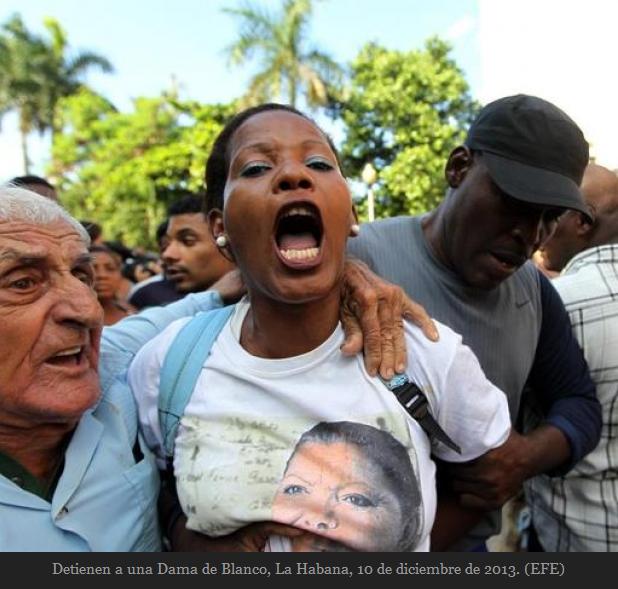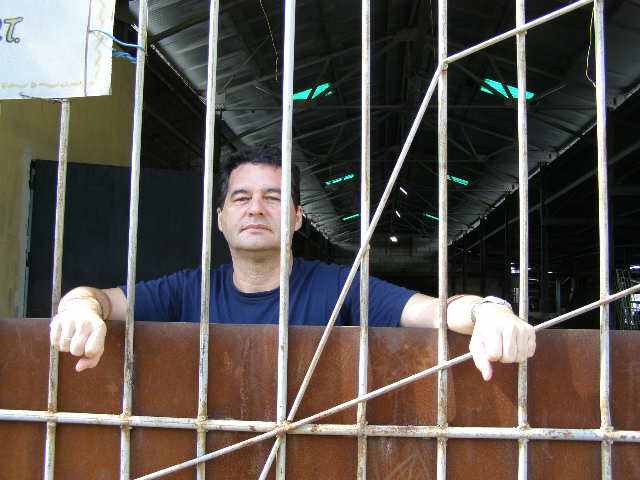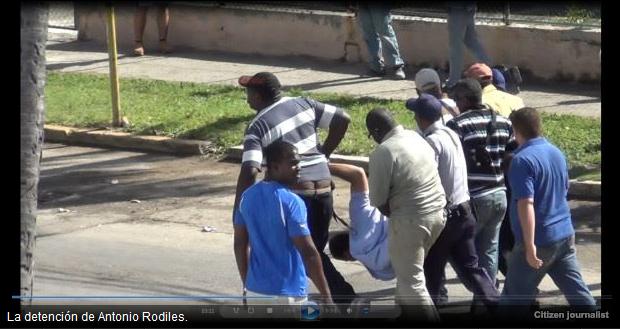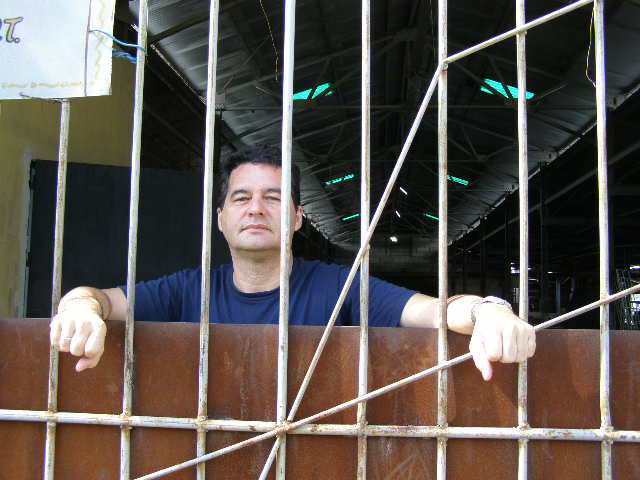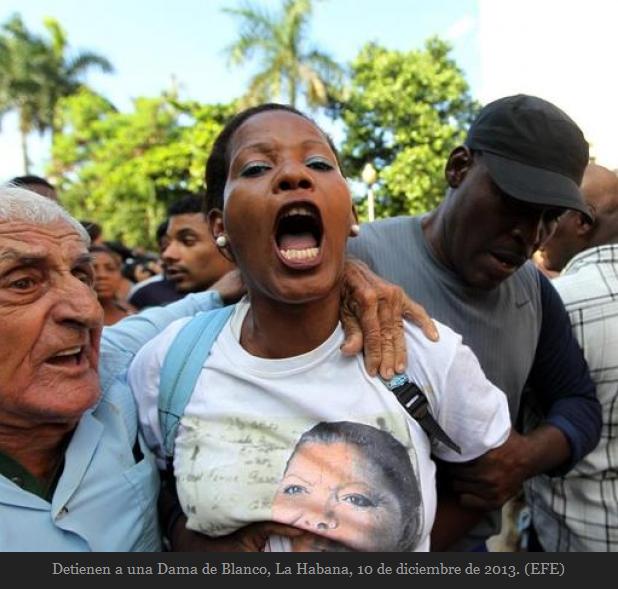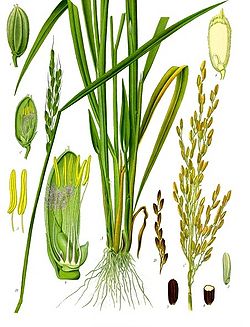1984, Here, Now / Rebeca Monzo
Sugar Anyone? / Rebeca Monzo
Defective Pots / Rebeca Monzo
Grim Violence / Fernando Damaso
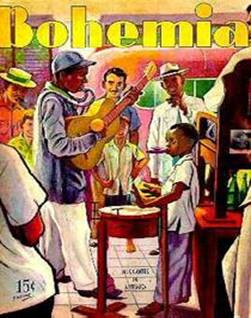 Violence in Cuba has a long history: it started with clashes between the aborigines fighting for territory, continued with colonization and slavery, and increased during the struggles for independence, where Spaniards and Cubans made unlimited use of it.
Violence in Cuba has a long history: it started with clashes between the aborigines fighting for territory, continued with colonization and slavery, and increased during the struggles for independence, where Spaniards and Cubans made unlimited use of it.
On the establishment of the Republic, it ceased to be practiced between Cubans and Spaniards, and went on to become the way of resolving contradictions among the former: the reelection bid of Estrada Palma, the violent struggles between parties, the rise of so-called independents of color, drowned in blood, and the dictatorships of Machado and Batista, plus gangsterism between them, are all clear examples.
The so-called centenary generation and their followers practiced it in the fifties, with assaults on barracks, sabotage, attacks and planting explosives in public places — things that today would be classified as terrorism — reaching its climax in the insurrectional fight in the mountains to take power. They achieved this, and instead of stopping, the violence grew with the executions, fighting the rebels and repression of those who did not share the ideas of the victors, continuing to this day with the repudiation rallies, beatings, imprisonment and prosecution of the peaceful opposition.
The powers-that-be, established for 55 years, have made this their form of governing. At first they tried to extend it to Latin America and Africa as guerrilla movements, and later with their direct participation in foreign wars, but they lost their financial and logistics support with the disappearance of the Soviet Union, and had to retreat and concentrate on the internal.
Today, violence exercised by the government spreads its harmful influence over Cuban society and prevents its economic, political and social development, blocking the way for dialogue and peaceful resolution of the problems. Hopefully in the next year, with the help of all, this situation will start to reverse itself and they will begin to behave intelligent beings, where reason comes first and not force..
19 December 2013
Cuba: Diplomacy and Repression / Ivan Garcia
 While General Raul Castro, a president handpicked by his brother Fidel, squeezed the hand of the United States’ leader Barack Obama at the State funeral of Nelson Mandela in Johannesburg, the special services and combined forces of the police mounted a strong operation around the home of dissident Antonio Rodiles, director of the Estado de Sats, a project where diverse political and civic strands that coexist in the illegal world of Cuban opposition come together.
While General Raul Castro, a president handpicked by his brother Fidel, squeezed the hand of the United States’ leader Barack Obama at the State funeral of Nelson Mandela in Johannesburg, the special services and combined forces of the police mounted a strong operation around the home of dissident Antonio Rodiles, director of the Estado de Sats, a project where diverse political and civic strands that coexist in the illegal world of Cuban opposition come together.
Also on December 10, while the headlines of the dailies of the world media highlighted on their front pages the leaders’ unprecedented handshake, the hard guys of the State Security were repressing activists in the eastern region of Cuba and detaining some twenty Ladies in White in Havana and dozens of opponents in the rest of the country.
All this happens under the indifferent gaze of ordinary Cubans, whose central objective is to try to get two plates of food to the table each day. Neither for the corner grocer, the individual taxi driver or people waiting for the bus at a busy stop was the greeting newsworthy.
The regime knows that an elevated percentage of the population remains in the bleachers, observing the national political panorama. What is of the people is to subsist, emigrate or see the way to set up a small shop that permits one to earn some pesos.
Meanwhile, the olive green autocrats clamor to negotiate. But with the United States. It does not matter to them, for now, to sit down to dialogue with an opposition that has unquestionable merit: the value of publicly dissenting within a totalitarian regime.
It has paid its price. Years in jail, exile, and repression. But neither the right which it should enjoy — of being considered a political force — nor the acts of repudiation and beatings, have cemented a state of favorable opinion within a majority of citizens disgusted with the lousy governmental management by the Castros for 55 years.
Here is the key. By being focused on the exterior, the dissidence does not count on popular support, on men and women who before the regime’s gross injustices throw themselves into the street to protest. That weakness is what permits the authorities to not take it into account.
I do not believe one owes a handshake to a ruler who represses those who think differently. This December 10 the Universal Declaration of Human Rights, of which Cuba is a signatory, turns 65.
No high flying political strategy has paid off after a series of steps that democratic countries have taken trying to push Cuba.
Neither the Ibero-American Summits or leading CELAC pro tempore have impeded the Havana Government in continuing to repress the dissidents with laws and physical violence.
Fidel and Raul Castro have dismissively mocked everyone and everything. They initialed the Economic, Cultural, Political and Civil Rights Pacts in February 2008, and later did not ratify them.
Cuba is the only country in the western hemisphere where the opposition is considered illegal. And the only nation that does not hold free elections to elect its presidents.
Cuba is not a democracy. Obama well knows it.
If behind that handshake, the second in a half century by a president of the United States (the first was that of Bill Clinton with Fidel Castro at the Millennial Summit in New York, September 6, 2000), there exists a discrete message about future negotiations to repeal the embargo or improve relations between the countries, ordinary people and a sector of the dissidence would not see it as a bad thing.
Maybe the greeting does not come to be something more than ceremonial and isolated. Or maybe a change of policy by the White House. The gringos have always been very pragmatic.
In a serious negotiation, both sides must give. The bad news is that the regime feigns change, but continues repressing the opposition. Diplomacy on one hand, clubs on the other.
Ivan Garcia
Photo: One of the Ladies in White detained Tuesday, December 10, during a peaceful demonstration for the Day of Human Rights on the downtown corner of 23 and L, Vedado, Havana. Taken by ABC.
Translated by mlk.
17 December 2013
Letters are Letters / Yoani Sanchez
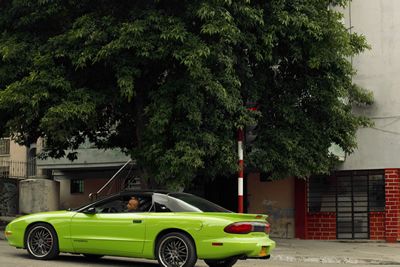
The morning’s news left Raidel speechless. Just when he was going to buy a car at a subsidized price, they announced the end of this mechanism of privileges.
Just to get the authorization letter, with signatures and stamps, had been the work of long months trekking from one office to another, one bureaucrat to another. The hardest thing was to demonstrate that his income came from the State sector, proving the origin of every penny earned from decorating tourist resorts. With permission already granted, he had endured four years on a waiting list of over seven thousand potential buyers. Until this morning, when his dreams of going to pick out a low cost Peugeot or Hyundai went up in smoke in the time it took to read a brief announcement on TV.
Recently, the Council of Ministers agreed to gradually implement the sale of modern cars — new or used — to any natural person, whether Cuban or foreign. Two years after the implementation of Decree 292, reality has forced them to widen the strict limits of this regulation. To the legalization or vehicle sales between individuals, they have now added the acquisition from agencies of cars with zero miles, or with more recent model years. We are going from permission only to trade in second hand products, to being able to obtain a “new package” with certain technical warranties… but yes, from State retail networks, at a price determined by the government and probably paying in cash.
A measure of this kind benefits the emerging middle class, eager to own ever more modern status symbols. As an immediate effect, it increases the social differences that have been growing dramatically in the last five years. Although the political discourse continues to speak of equality and opportunities for all, this relaxation is directed at those who have high incomes in convertible pesos. They are the big winners of the day, while the losers are Cubans like Raidel, whose authorization letter to buy a car barely has value as a museum piece. People who after years of applauding, faking and working hard, understand that today the market as been imposed over their professional and political merits.
19 December 2013
When Cuba Had No Christmas / Ivan Garcia
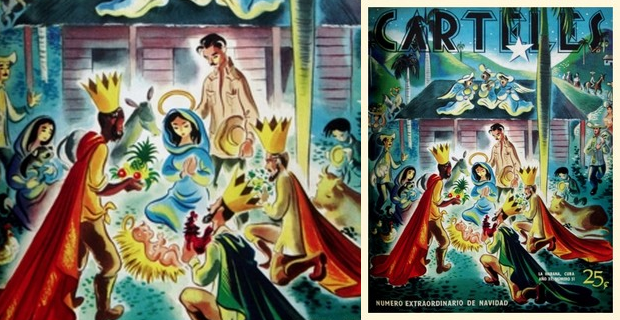
The first time Juan Carlos saw a Christmas tree, he was 43-years-old and working as a bricklayer inside the house of a top counterintelligence officer.
“That was 19 years ago. Those were the harsh years of the so-called Special Period. People had nothing to eat. Avocado was a luxury and a pound of rice was 60 pesos. Due to all sorts of vitamin and nutritional deficiencies, men and women succumbed to illness and some even lost their natural teeth. Back then, I was a civilian worker for the Department of the Interior and our crew was asked to work on painting and remodeling the home of a State Security bigwig. The guy was living at full throttle luxury. His kitchen was a quarter size bigger than the tenement room where I was living. That was the first place I ever saw a Christmas tree.
Cubans are not atheists or Muslims. No, sir. Before Fidel Castro’s autocratic regime, the poor and rich celebrated Christmas if on different budgets.
The same could be said for Three Kings Day (Epiphany), and Easter celebrations. But our radical commander launched a crusade against reproducing the slightest hint of the bourgeois lifestyle. He opened fire on the Church, on free thought and on abstract painting. Down with the Three Kings. Now, our New King Magus dressed in olive green fatigues.
In 1959, Fidel climbed aboard an aircraft and made it rain toys for children of the Sierra Maestra who’d never owned such a thing. But in one fell swoop, by the end of the 60s, he eliminated all mom and pop shops and Christmas.
Gustavo, a 72-year-old retiree, remembers, “Only New Year’s Eve parties were left standing, and even those came to be used to celebrate the anniversary of the Revolution. The pretext used to eliminate Christmas and the Carnivals of February was that such events shut down sugar cane production. In his madness, Castro had invested all of Cuba’s resources to attempt the production of ten million pounds of sugar per year. The effort failed. Cuba’s economy payed dearly for such folly.
Just like the State openly frowned on the Afro-Cuban and Catholic religions — Castroism was the only acceptable religion — Christmas had to be suspended until further notice. Of course, you can’t really change anyone’s beliefs by edict.
“Some neighbors would very discretely place Christmas trees in their family rooms. They’d also shut the windows so neighborhood whistleblowers who patrolled for the Committees for the Defense of the Revolution (CDR) couldn’t see any of the tiny Christmas lights. When pig was roasted, the aromas were carefully masked and Christmas Carols were barely audible,” reported Aida, a 69 year-old housewife.
It was a long journey through the desert. Even parties had to be authorized by the state. The government tried to micromanage every detail of your life.
To avoid being singled out as a counterrevolutionary, you had to attend political meetings and participate in government parades. If you aspired to housing, a Soviet TV or an alarm clock, you had to list accumulated merits in the workforce and enumerate your revolutionary accomplishments.
You gained points if you’d fought in Angola or Ethiopia, if you were militia, if you worked lots of volunteer hours, and if you could quote good chunks of the Maximum Leader’s (Fidel’s) speeches by heart.
You lost points, if you owned a Bible, went to church, got mail from relatives in Miami, listened to the Beatles or Led Zeppelin, liked Levis blue jeans; with these characteristics you did not qualify to buy an Inpud refrigerator or two-speed Karpaty motorcycle.
To blacklist you, any envious neighbor or political extremist could turn you in to Special Services if you were caught celebrating Christmas or giving your kids any toys on January 6 to celebrate the day the Three Kings (the Three Wise Men) arrived at Jesus’ manger.
To keep himself in power, Fidel had to do all kinds of ideological backflips. In Europe, the Berlin Wall had fallen, and the U.S.S.R. — the mecca of Communist looney wards — had disappeared. Somehow, he had to cling to whatever branch could sustain him.
The regime eventually sealed a pact with a docile Catholic Church. People who once professed a belief in Yoruba syncretic spiritualism (Santería) again nailed old and familiar amulets on their doors.
In December 1997, Pope John Paull II visited Cuba and Christmas returned.
But all along, the official Nomenklatura never stopped celebrating Christmas if you take into account all the roast pork, all the traditional sweet Spanish nougat and all the wines consumed.
Maybe those folks could indulge because they thought of themselves as being above the rest.
Iván García
Photo Credit: Front cover of winning lottery number sporting a Criollo Christmas image and published in the magazine Carteles in 1959. Up until 1959, we had Christmas cheer on the Island. You could find the popular A Cuban Merry Christmas postcard celebrating the Cuban book and reading fair, and the advertising sign for A Boy’s Cuban Christmas printed by the Ministry of Culture and with pictures of the Three Magi done by René Portocarrero. The Book of Cuban Recipes, launched for Christmas and edited by the Ministry of Education, carried a special introduction: “This Christmastime, a book of traditional Cuban recipes was especially created so every young city-dwelling housewife can come to know and enjoy the traditional cooking that forms part of our national heritage and still endures in various parts of the country.”
But during the 60s, Christmas started to disappear from the life of Cubans, and only a few kept up with the tradition from behind closed doors (Tania Quintero).
Translated by: JCD and others
17 December 2013
Communique: Castro, The Guardian Of Human Rights In The United Nations, Returns To Harass And Threaten Angel Santiesteban
A few days shy of ten months of wrongful imprisonment, after a show trial in which they have never proven one of the crimes brought against him because he never committed them, and without which the prosecution hasn’t responded to the appeal for a review of the case which submitted by the lawyer Amelia Rodriguez Cala on July 4th of this year, in the Lawton prison settlement where he is now detained since his birthday (August 2), Ángel has started being harassed and provoked by his jailers, in what we consider a clear strategy to push him to commit any misconduct that would justify a new transfer to a stricter regime of prison or which would allow his accusers to prove his supposed violent nature in the retrial, after which, if the Cuban legal structure works, they will be required to release him.
These are not isolated events: the re-educator had already tried to set the other prisoners against Ángel and told them he would put him “in a box”. Inmates assumed he was referring to a coffin, but another reading could be that Ángel would be “tamed with dirty or violent methods.”
Then on Friday the 13th during the night, the settlement was visited by the new head of CETEM, the Major Cobas, along with the aforementioned re-educator. Ángel recounts that: “The other night they searched me, there was the head of the camps, as the Chief re-educators, and I did not permit him, he opposed me then threw my stuff on the floor and kicked it so that I could not touch it. They told me that it was a serious breach of discipline and that they would make a record of it immediately. Then they took all of my belongings and searched them.”
How far do you plan to take the abuse dictator Raul Castro, now shelterd by the Human Rights Council of the UN? Shame is what all the member countries of the UN which sit on the Council should feel towards this systematic violator of all rights and freedoms of the Cuban people, who only seeks to extend his archaic but deadly reign of terror to the rest of the continent.
All international press with dignity, last December 10, the International Day of Human Rights, showed the world what the pathetic UN Council was trying to hide: the Cuban government celebrated that day by repressing its opponents in what is considered one of the darkest days of repression in Cuba. But the truth always triumphs, Mister Dictator. And Justice too, of that you should not have the slightest doubt. But if you do however, study some history.
I repeat what I have told you many times, you and the whole army of thugs at your service are absolutely responsible for the life and safety of Ángel Santiesteban-Prats. And remember that while the world is watching in horror as you send paramilitary mobs to beat up peaceful Ladies in White carrying gladioli as the only weapon and as you use children as shields in acts of repudiation against those who think differently and also serves as a witness of the most abhorrent scenes of physical violence against activists who, moreover, weren’t even demonstrating in the streets, as was the case in the door of the headquarters of Estado de Sats; that same world continues to recognize the talent of Ángel, rewarding him, as happened in September when he was awarded the Franz Kafka International Prize for Novels from the Drawer, and they paid tribute to him, just as he received a few days ago in Montreal. Oh how it hurts! Doesn’t it?
So do not forget this: You are responsible for what happens to Angel, and for the orders which you give to your henchmen. The world is watching.
The Editor
Translated by: Shane J. Cassidy
18 December 2013
URGENT: Angel Santiesteban Harassed And Threatened In The Prison Of The Regime Which Is A Member Of The UN Human Rights Commission
The incommunication problems because of our lack of internet connections in Cuba have prevented us from offering, as it should have been, the inside scoop on the harassment and threats that the writer Ángel Santiesteban-Prats is suffering since early this month at the prison in which he is currently located. We were hoping to offer firsthand reports narrated by Angel, to those witnessed by the family who related this to us by phone.
But not even these communication problems have gotten the regime off the hook: the journalist Dania Virgen García sent from the island an article denouncing this new violation of the rights of Angel. It proves once again that there are many who are willing to stop the injustice committed against Angel from going unpunished.
We publicly thank Dania Virgen García and all those who have already reproduced this article in their blogs and other digital media.
The Editor
Here is Dania’s article:
Lambasting in the prison of the writer Ángel Santiesteban-Prats
by Dania Virgen García
Havana, Cuba, 17th of Decebmber 2013, Dania Virgen García/www.cubanet.org.-
In the penal settlement of MININT (Ministry of the Interior), in Lawton, in the Havana municipality of Diez de Octubre, where the writer Ángel Santiesteban-Prats is held, the re-educator tried to use the common criminals against him, this past 11th of December.
In the ten months that the writer has been held in the settlement, he has never participated in the physical countings, inspections or political activities.
On the day in question, Santiesteban remained in the barracks, when the prisoners were called to be counted. The re-educator, not seeing the writer, was annoyed and began to shout insults against him.
Then, from the mouths of the prisoners themselves, he knew that the re-educator had said he would put him “in a box”. The inmates assumed it was a reference to a coffin.
The reeducator said, moreover, that he would make a report to his superiors for his misconduct and that Santiesteban was not a political prisoner.
The inmates realized that reeducator had lied, because some of them have seen the writer’s ID card which has a green stripe that crosses from one side to another, and over it are the letters CR (counter-revolutionary), and under his picture the is the word “Warning”.
On the night of Friday 13, the settlement was visited by the new head of CETEM, Major Cobas, who tried to provoke and question the writer.
Since entering prison, the writer Santiesteban-Prats has never eaten prison stew; instead he eats the provisions which his family has sent him. He is never seen dressed in prison clothes and he has never accepted the personal supplies which are given to the prisoners.
He was withdrawn on April 9th this year, from the camp of forced labor known as CETEM, La Lima, located in the town of Guanabacoa, to Prison 1580, with the intent that he will not be present during the visit of international journalists who were manipulated by the regime officials.
Currently, the Casa de las Americas Prize for narrative maintains the same denial in the settlement.
Santiesteban thinks it was naive of the jailer or else that the new boss wants to provoke him, thus causing a prison indiscipline, accusing him of a crime to be able to send him to a closed prison. He suspects that the guards are being manipulated by the repressive Department 21 of the State Security.
Rest assured that whatever the intention, he will remain with his principles and ethics, which he has maintained in the 10 months he has been held for an alleged domestic assault that the trial could not prove.
Translated by: Shane J. Cassidy
17 December 2013
Living in a Shelter: The Tragedy of Thousands of Cubans / Lilianne Ruiz
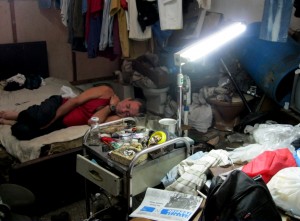 HAVANA, Cuba, December 2013, www.cubanet.org – The poverty in which most Cubans live — and to which they adapt, thanks to the meticulous mechanisms of power that 54 years of State terror have imposed — is not an insurmountable fate. It would be enough for the Cuban government to respect all human rights, opening the political and economic game, in order to improve the living conditions of the island’s inhabitants.
HAVANA, Cuba, December 2013, www.cubanet.org – The poverty in which most Cubans live — and to which they adapt, thanks to the meticulous mechanisms of power that 54 years of State terror have imposed — is not an insurmountable fate. It would be enough for the Cuban government to respect all human rights, opening the political and economic game, in order to improve the living conditions of the island’s inhabitants.
Misery is aggravated when one has neither a place to live nor economic resources to rent, build or buy a house. It is estimated that, in the Central Havana municipality alone, 6,201 families (24,584 people) are affected by the uninhabitable condition of their dwellings. Of that number, only 125 families are located in the so-called transit communities: collective shelters, as they are known in Cuba.
But those figures do not shed light on what it means for a family to live sheltered. One must cross the threshold of figures in order to see up close the true face of the tragedy.
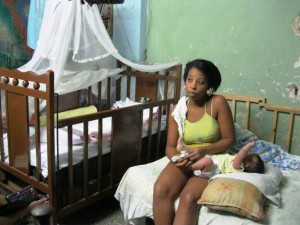 The “Collective Shelter” of San Rafael 417 in Central Havana
The “Collective Shelter” of San Rafael 417 in Central Havana
According to those who live there, the building previously housed a factory for sanitary napkins (intimates in the Cuban language). Decrepit posters with some communist slogans are not missing. The hall is divided into different rooms where the belongings of those who have come to stop in this site are grouped. What seems to be the bathroom is in fact a latrine. Nor is there seen anywhere a sink with running water.
Iverlysse Junco is 29 years old. The door of the little room of wooden planks where she lives with her husband and four children creates a false illusion of privacy. Everything looks poor and ugly, but it is impressive to see the white of the diapers that cover the cradle of her baby born a month ago. She has not neglected her personal appearance in spite of the fact that she is not expecting anyone; she keeps her dignity in the cleanliness and order that she maintains in the 4 x 4 meters where they live.
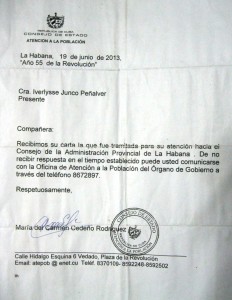 Six years ago they left a tenement in danger of collapse. The room has not a single window. The first thing that she shows us behind a curtain is another sliding wooden plank that gives onto the street.
Six years ago they left a tenement in danger of collapse. The room has not a single window. The first thing that she shows us behind a curtain is another sliding wooden plank that gives onto the street.
“When we came it was completely closed, but one day I could not endure any longer the lack of air and I grabbed a saw in order to make that opening,” she says. “The bad thing is that now my husband and I cannot leave together, because one of us two has to stay in order to make sure no one enters and takes our things. They came to assess a fine against me, for nothing less than for altering the facade. But I told the district delegate that they are very familiar with my situation.”
On an improvised kitchen counter is a pair of electric burners where she does everything: from cooking to boiling the diapers, as is customary among Cuban mothers who have no way to pay for the luxury of disposable diapers, which involves a greater cost than a month’s salary.
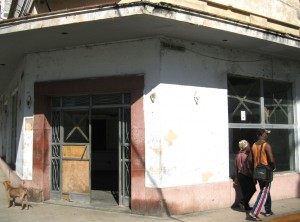 The baby is cold as a consequence of the humidity: she has to hang out clothes there inside. The water she asks of a neighbor on the block. He lets them fill the buckets that they then carry to a little tank in the corner of the room. That limited water has to serve them for washing, mopping, cooking and bathing in the same room. Part of everyone’s routine every day is to keep the deposit full. But with other needs there is no arrangement; they have to urinate and defecate in a bucket dedicated to that purpose and then go out to pour it down the drain in the street.
The baby is cold as a consequence of the humidity: she has to hang out clothes there inside. The water she asks of a neighbor on the block. He lets them fill the buckets that they then carry to a little tank in the corner of the room. That limited water has to serve them for washing, mopping, cooking and bathing in the same room. Part of everyone’s routine every day is to keep the deposit full. But with other needs there is no arrangement; they have to urinate and defecate in a bucket dedicated to that purpose and then go out to pour it down the drain in the street.
“Everything is hard here. The most difficult is getting up in the morning and having to be watching the people to be able to go out to dispose of the bucket. I cannot not have the bleach for cleaning and the freshener.”
Her husband works in demolition, which is why she is aware of the quantity of collapses that occurs, especially when it rains.
“When do I leave here? The collapses are going to continue because Havana is falling down.”
Although Iverlysse and her husband work a lot, they see themselves reduced to total dependency on the State. In a collectivist system, which condemns private property and the free market, the hypothetical solution is that, not with one’s own effort, but with collective work, the Junco family will get a house in which to live.
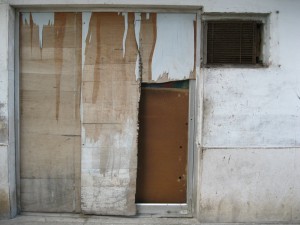 In practice, society has submitted to state control and planning. The happiness of the Junco family depends then on their file being privileged in the eyes of the official, who next December 20 will have to decide if, among the 900 cases that are presented in the whole of the Havana province — after prioritizing the “cases” that have spent 20 years sheltered, hoping — theirs qualifies as sufficiently affected by an extreme situation.
In practice, society has submitted to state control and planning. The happiness of the Junco family depends then on their file being privileged in the eyes of the official, who next December 20 will have to decide if, among the 900 cases that are presented in the whole of the Havana province — after prioritizing the “cases” that have spent 20 years sheltered, hoping — theirs qualifies as sufficiently affected by an extreme situation.
“I have already gone to the Province (Office of Dwellings) and to the government. Three times I went to Revolution Plaza and seven times I wrote letters to the State Counsel. On all those occasions the answer was: You have to wait. There are worse cases than yours. What can be worse than this?” Iverlysse asks herself.
The statistics about the numbers of sheltered people and those waiting to become sheltered, were offered by the Municipal Unit of Attention to the Transit Communities (UMACT) of the Central Havana municipality by a person who requested anonymity. The number of the 900 cases that will be presented next December 20 was provided by a housing worker who also wanted to withhold his name.
December 15, 2013/ By Lilianne Ruiz.
From Cubanet
Translated by mlk.
Images of the Day Before / Orlando Luis Pardo Lazo
The image of the island has been abused in our national imagination.
The island as isolation, as continental abandonment, as lyrical gentleness, as the least firm of the earth, as origin and teleology, as unsinkable (unbearable) cork, as poetic cause of the measure of all things.
Cuba can be this and much more, surely. But Cuba is, above all, illusion. An endemic disease called hope. And, more than illusion, Cuba could be pure instinct.
We can violate the etymology of “instinct” and define it starting from “instant.” The instantaneous, the snapshot. What can not be re-read a moment later and therefore must be fixed before it disappears. The precarious.
And we are talking, then, about photographs: the most common of household objects, the most commercial, the most immobile of genres, also the most democratic (like with firearms, whether we have a license or not, we can all go out and shoot: click, flash).
Each frame is a part of the same film, a documentary trailer of socialized dreams that nobody is in a hurry to wake up from. Half monstrous dreams meant to engender reasoning, but they ended up engendering rationing and cynicism.
Involuntary snoring to sustain our own voice. Free tracheotomies with which the system tattoos us voluntarily, perhaps before birth. Artificial respiration of the broken motor of a thousand and one horizontally positioned generations: the pose that attracts the least attention from authority. The fetal posture, which is still what most protects us (that other illusion of returning to the womb where the social damage still hasn’t touched us).
Pedestrians in peace, lying on the metropolitan dirt, at risk of being trampled by the flows of desire and urban footwork of the capital. Self-capitalism, a minimal market whose geography is so incipient.
Barefoot and decrepit, against the columns, as befits an uncivil citizenship. A country cannot be commanded like an encampment, of course: it’s as if every countryman were in his own encampment. Anyway, in the end we are discovered because Havana is exactly the impossibility of an interior space. Everything is open, everything exposed, political promiscuity where the forbidden rules, sites of maximum visibility. Paternalistic surveillance childish punishment, while we change our make-up every day so that no one or nothing changes us from year to year.
And also a touch of animal tenderness. And another bit of humor, as a reminder of the human condition misplaced in some legal loophole. The Cuban Constitution as a gag, a shroud, a memorandum of the equitable death by official decree. In the photos, the ephemeral becomes eternal, glance becomes matter, either by an inspired stroke of composition or by a miracle of chance (or by both).
Be it a nightmare or be it human sorrow, be it civil abandonment or be it solidarity. But a snapshot is always a climax of intensity. Impromptu, almost unbearable for its unexpected character, often intolerable.
In a desert climate like that of Cuba (red hot ideology by day, by night masses chilled between hypocrisy and idiocy), in a claustrophobic atmosphere, of hysterical enthusiasms and national apathy (with blind lines of flight to an outside, an outside often suicidal), in a landscape of cracks that boast of their rudeness, a landscape reduced to a wasteland where even repression is boring and God seems a yawn, there is nothing more inviting than intensity. Nor anything more impossible.
Without this accelerated raw material, there would be no event nor creation. The intensity of the caught instant lifts what was just a mute act to its most inconceivable symbolic resonances. The intensity is a vector that goes from the physical to the metaphorical, from light to illumination, from earth to air. Ultimately, from the political to the poetic. The intensity can even be invented, and in the end always contains traces of truth.
Instant, stop: you are so beautiful … What are the symptoms of such beauty?
The fall, the scaffold. Emerging make-believe, unknown forces in secret tension, momentum (which in physics is connected with mass and velocity), commonplaces on the point of disequilibrium (the instant as an announcement of the unusual), Cuba as collision.
After decades of decaying bodies, erased by mass statistics, suddenly Cuba is conceived as recovery. The urgency of motion erases the vocation of eternity of the image. Diaphragms wide open, provocative. Temptation of a liquid light, dripping. Humidity of a story already without histology. Sensuality confronting censorship. Eros, rather than heroes. Reflections, more than rhetoric. Revelation, rather than revolution.
And amid the chaos, the fragmentary not so much as an aesthetic solution, but as a strategy against the notion of absolute. The fragment as private ethic of the individual: the part against the total, anti-fractal theory, post-metonymy, implausible versions of the truth, the incomplete as fragility but also as resistance to the tabula rasa that is the legacy of all totalitarianism at its terminal phase. Rewriting of official iconography. Iconoclastic revenge, long overdue for art in Cuba, and long penalized for its artists. The palimpsest as the antithesis of the very monolithism of any wall. It is, in the end, the discarding of a tradition that was announced to us as perennial.
The accumulation of layers of meaning begins to outline a kind of archeology of wiping the slate and starting new. The great wall of Havana is now open like a large mural. Amnesia is friendly like a benevolent madness that takes us back to childhood. I suspect we socialize in the style of a senile zombie.
In this new narrative the residues and sketches predominate. In this new no-narrative contamination in its beneficial sense predominates: the dilution of the grandiloquent speeches, the minimal disseminating deeply without anyone noticing it, while the pictographic ruins of our stateless Pompeii will become ever more difficult to decode.
Inhabitants of barbarism, syllable by syllable, we can still recognize a certain sense of meaning, but in practice we have forgotten how to read: today the words and phrases give us the impression of having been emptied of content, of being chiseled from an obsolete language, sometimes obscene. Havana as a dead language, a Martian tongue, a kind of Latin argot taken to its very limits. Paradoxically, this illiteracy in Cuba is our only guarantee of access to the future. Not understanding protects us from participating, for example, of the ridiculous despotisms of the propaganda. Of the verticality and outbursts of power. Not understanding, too, is a supreme act of insubordination, of subverting the signals of consensus, to be ultimately, subjects beyond all logic and all governability.
Abandoning the tired habit of interpretation can be the unpredictable first step towards freedom. More than a vocabulary, we depend on a vocabul-arid. Dryness of repetition, patterns of argument that are repeated ad nauseam. Invisible verbal violence, not so much through public offence as through the secrecy that provokes panic and terror. It’s those innuendos that threaten and grip the Cuban soul, beyond the myth of insularity and its exception exiles. More than a vocabulary, we hang by a voCUBAlary.
Even love and desire are based on these synthetic ambuguities, accumulated privileges, phobia of the other. Not only phobia of the different but phobia of the identical. Homophobia, in its universal sense:fear of the other, the drive to annihilate.
Sometimes one is tempted to accept that language exists because communication is impossible. There is no message now that could overcome the force of gravity, everything tends to precipitate. The ground prevails here above the ideals. There is no ideology which at these times doesn’t look a bit idiotic. Paradise, fortunately, is lost, not so much deserted as defected. Perimeter marks were left, rigid limits for being already so sclerotic, the bars that define the magnitude of the trap: the panopticon as orthopedics so that the intellect does not insist on existing as such.
Mercy will be left, which was mistreated by the glance, the urgency of a gesture of salvation that restores the prestige of naivety. Cutting of silhouettes, Cubanesque shadows on the claustrophobic backdrop of the horizon. Straitjackets, forgetfulness that obliges the posthumous to prevail over the probable, where a perfect past prevents the uncertainty of all futurity. Time coagulated, achronological. Architecture understood as archeology.
Maps, elementary geometry, recurring itinerary like the dreams we don’t dare to stop dreaming. Theory of the labyrinth. The art of waiting. Audiovisual coda of those who have lost hope for a new signal. Counterlight to countercurrent. The image of the Island is inexhaustible in our national imagination. The island that rises from its own ashes, like a Phoenix or maybe a malephic Aleph, magic object of the multiplicity, where all the times are still possible, schizophrenic at the same time. The spontaneous reaction against decades of paranoia could be hidden over there: to lose one’s face, to be others in another place, not belonging, giving up a national grammar that called no one and for the good of no one. We elude ourselves right on the day before: if the transition will be just a theatrical trick, then we Cubans today choose not to play on the day after.
Orlando Luis Pardo Lazo
From Dissidence (in English)
Is Cuba Now Celebrated by UN As Custodian of Human Rights Despite Blatant Violations? / Angel Santiestebad
We are all too aware Cuba’s dictatorship does not possess the slightest modicum of remorse or self-reproach, so we cannot ask such a State to behave honorably. The Cuban dictatorship is not worthy of respect. Time to stop looking in vain for something that is just not there. Best we just resign ourselves to reality. If anything, the serious question that begs asking is why certain governments keep close ties to our two warlord brothers. Not easy to stomach how some apparently respectable and democratic nations accept having Cuba take on the presidency of CELAC.*
Before allowing Cuba to become a bona fide member, the proper thing would be for the UN to kick Cuba out of the Human Rights Council. Just how on earth has it become possible for the Castro brothers to — without any trace of unease or embarrassment – shamelessly mock the international community of nations under the auspices of the UN?
In Cuba, on Human Rights Day what the State commemorates is the opportunity to violate as many human rights as possible. On that Day, all manner of human rights are violated in a proud and peerless display of the Regime’s totalitarian access to military and judicial might. Dozens of women from the honorable roll call of Ladies in White (Damas de Blanco) were beaten and arrested in front of people who remained silent for fear that any alliance to the voice of opposition — no matter how humane or reasonable — would spell reprisal from oppressive government forces. Once again, people did nothing to stop the abuse and humiliation of their fellow citizens. At the home of Antonio Rodiles — a.k.a. the SATS headquarters for open thought — Calixto Martínez, Kizzy Macías and Rodiles were all taunted and later arrested in order to contain the initiative for Human Rights meetings that openly challenge the regime and its totalitarian laws.
I am convinced and pray to God that one day soon we will be able to celebrate the Rights every human being born on this planet has the right to enjoy in order to be protected from Fascist states. The very fascists states shaped after WWII but unknown in Cuba.
When that day dawns, we will exalt those brave enough to suffer mental and physical abuse under this regime. And those who keep silent or feigned support to the current dictatorship will only feel shame.
Fair to say that despite the State’s hatchet men and the well-oiled machinery of repression, Human Rights Day on December 10 was still felt on the Island archipelago.
Down with Dictatorship! Nation and Freedom!
Ángel Santiesteban-Prats
Lawton Prison settlement. December 2013
Translator’s note: CELAC – Community of Latin American and Caribbean States. An organization created to promote deeper intergration within the Americas.
Translated by: Shane J. Cassidy and JCD
16 December 2013
North Americans Eye Opener in Havana / Miriam Celaya
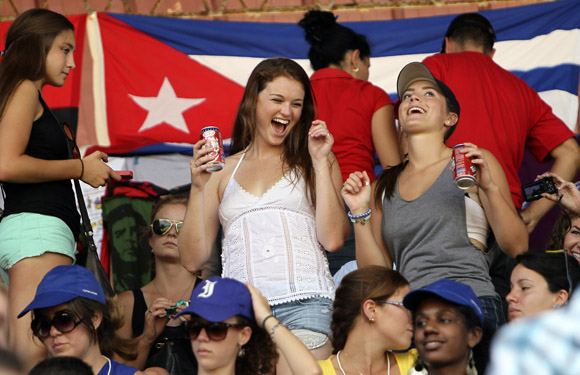 HAVANA, Cuba, December, www.cubanet.org – During the days when the cruise ship Semester at Sea was anchored on Cuban territory, over 600 visitors, including students and teachers -mostly Americans– carried out a tight schedule of “meetings” with Cuban university students and toured “sites of historical and cultural interest”.
HAVANA, Cuba, December, www.cubanet.org – During the days when the cruise ship Semester at Sea was anchored on Cuban territory, over 600 visitors, including students and teachers -mostly Americans– carried out a tight schedule of “meetings” with Cuban university students and toured “sites of historical and cultural interest”.
The December 11th edition of Granma published some of the opinions of the young northerners during “a brief meeting with reporters”: “I had never been so well received by the population as we were here,” commented a student from the University of Nebraska, while another one from the University of Virginia said that “Cubans are very welcoming”.
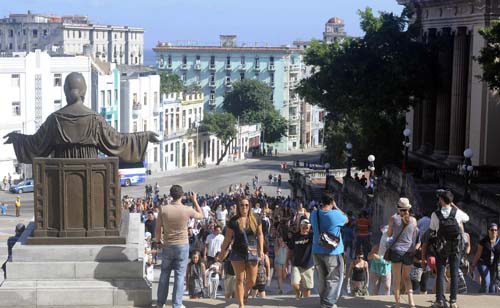 But according to some in Havana who tried to contact the visitors, there was a strong undercover operation, with agents dressed as fruit vendors, pedicab drivers and even “pompously attired mulatto women” -those who dress in costumes around Old Havana to entertain tourists- monitored the area the whole time the cruise ship was anchored at port.
But according to some in Havana who tried to contact the visitors, there was a strong undercover operation, with agents dressed as fruit vendors, pedicab drivers and even “pompously attired mulatto women” -those who dress in costumes around Old Havana to entertain tourists- monitored the area the whole time the cruise ship was anchored at port.
Other undercover individuals were posing simply as regular Cubans. However, Cubans’ sense of smell was not fooled when it came to identifying members of the pack of hounds.
Cubans who were interviewed by the visitors in each of the official program activities were selected among the most loyal communist militants, while Castro journalists covered the visit with their usual triumphalism, as if this were about another one of Castro’s achievement.
 But despite the careful planning of the visit’s programming by the Cuban authorities in the interests of the government’s political promotional agenda, and despite the students’ lack of contact with the population or with the diverse independent civil society, a group of them, despite controls of the political police, attended songwriter Boris Larramendi’s concert offered at the home of Antonio Rodiles (Estado de Sats), where they held a live dialogue with those in attendance, according to testimony of blogger Walfrido López, who was later detained at a police station after being violently arrested along with Rodiles and other activists and dissidents.
But despite the careful planning of the visit’s programming by the Cuban authorities in the interests of the government’s political promotional agenda, and despite the students’ lack of contact with the population or with the diverse independent civil society, a group of them, despite controls of the political police, attended songwriter Boris Larramendi’s concert offered at the home of Antonio Rodiles (Estado de Sats), where they held a live dialogue with those in attendance, according to testimony of blogger Walfrido López, who was later detained at a police station after being violently arrested along with Rodiles and other activists and dissidents.
These students heard first-hand testimonials from those who are vying for a new Cuba, and they learned of repression and terror. They were also witnesses of the repudiation rally organized outside the home of Rodiles, in which the authorities had no qualms about using elementary school children, high school teens, and musicians who are eager to keep their perks and travel privileges, as in the case of Arnaldo y su Talisman. Arnaldo may need a huge talisman someday to explain his criminal complicity with those who repress other Cubans.
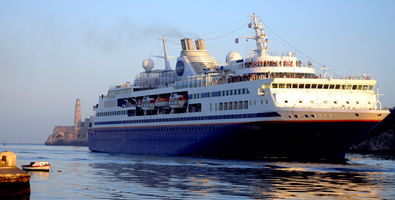 There may probably be other trips and exchanges with these and other American students. Many of them reported the lack of information they have about the Cuban reality and about the true nature of the dictatorship. Hopefully these visits, laden with messages to the free world will recur. Totalitarian regimes don’t have antidotes against openness, and the satrapy will definitely not be able to keep hidden any longer the slavery and repression it has imposed upon Cubans for 55 years.
There may probably be other trips and exchanges with these and other American students. Many of them reported the lack of information they have about the Cuban reality and about the true nature of the dictatorship. Hopefully these visits, laden with messages to the free world will recur. Totalitarian regimes don’t have antidotes against openness, and the satrapy will definitely not be able to keep hidden any longer the slavery and repression it has imposed upon Cubans for 55 years.
Miriam Celaya.
Translated by Norma Whiting
From Cubanet, 15 December 2013
The Rice Boobytrap / Rosa Maria Rodriguez
Count on earthworm remains, bits of assorted garbage, tiny jaw-breaking pebbles, and the odd piece of moon rock mixed inside the minute ration of the people’s rice being offered by the State; this is the quota for December which was released for sale November 30 in the bodegas (ration stores) in Vibora and everywhere else. Go figure why the government chose December — a time when many families celebrate various Christmas or New Years gatherings and meals — to get rid of a large portion of dirty and off-color rice more fit for bird than human consumption. All that the store manager at my “designated” bodega could say was that the grain crop available was from Pinar del Río (West of Havana) and was the only rice supply being distributed to consumers in the Tenth of October (Diez de Octubre) municipality of Havana.
I went to another local bodega and got the same song and dance. My gripe upset a neighbor to the degree that I got scolded for taking a stance. I was soon reminded how some brownie point seeking official would be chomping at the bit for the opportunity to nag us for hours on end — and pep-rally style — about the great job the State does for the people by providing free rice. Beyond that, we would also get some impromptu group shouting slogans thanking the Department of the Interior for poultry, pig or any other State farm for giving us such piss poor quality products. Fine. But nearly inedible State products are unnerving: Cuban family members trying to put decent food staples on the table are forced to endure unbelievably time-consuming and exhausting hardships just to make a meal edible.
Most exasperating of all: Why can’t rice ever be “deregulated” so restrictions can be lifted and we can buy whatever we would like or can afford to pay? Instead, like helpless slaughterhouse pigs, we always get the same condescending mantra: “Eat the stuff or eat the stuff.” For consumers, the outrage ultimately becomes subsumed in listless apathy — or oddly enough — a pact of collective silence when the State decides to run roughshod over our rights. Almost imperceptibly, people do murmur. Many are alarmed the local rice crop might suffer the same fate as our potato production when a substantial Cuban government subsidy to Bolivia all but eliminated potatoes from our sight for most of 2013.
An elderly neighbor tried to console me by saying, “Listen: If you cook it, it’ll taste O.K.” But honestly, after wasting three whole hours sifting and washing rice to clean the grain, I could care less about the flavor, the quality, or whatever the rice’s appellation of origin might be.
Translated by: JCD
3 December 2013









